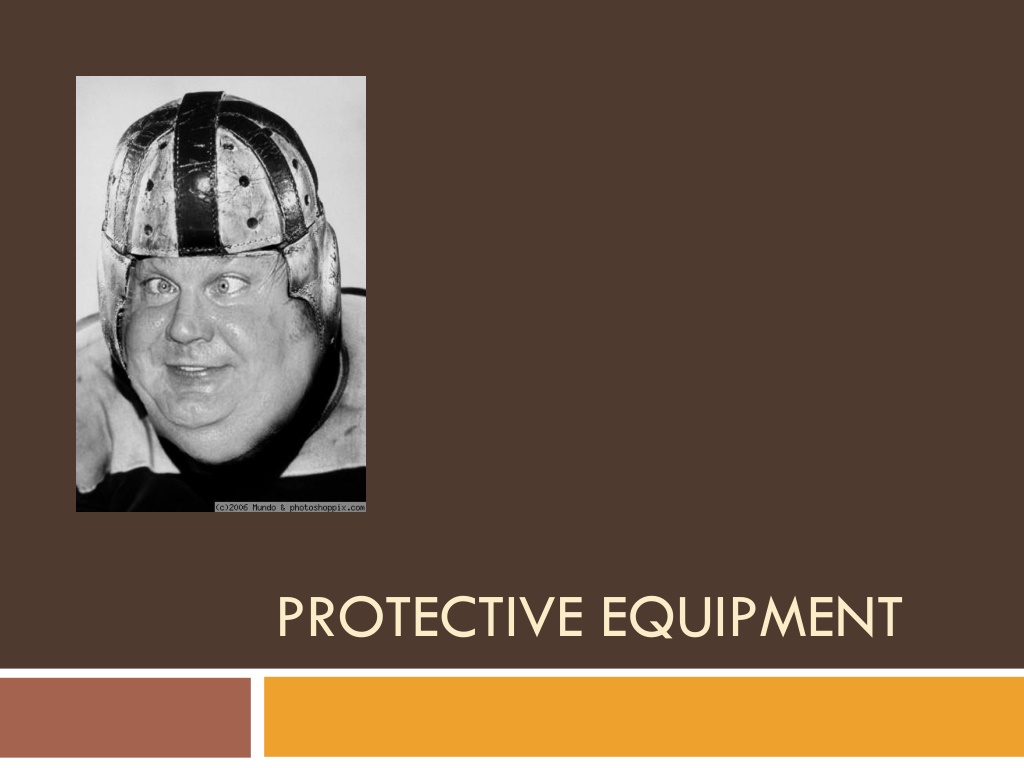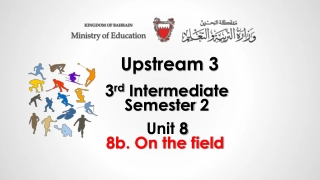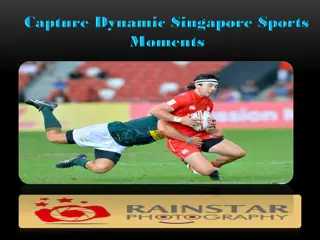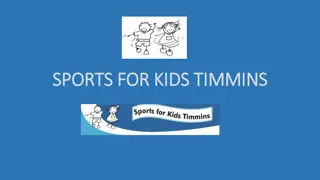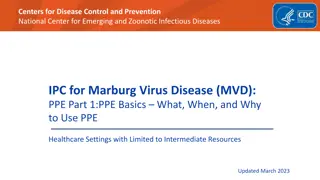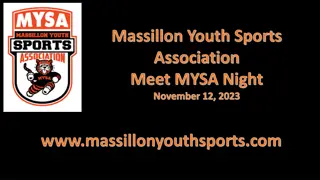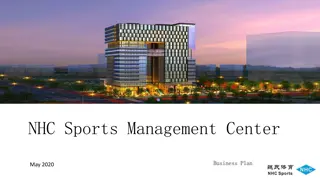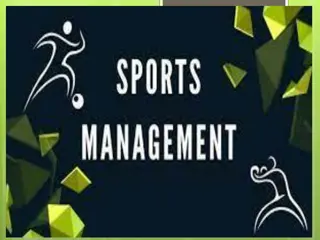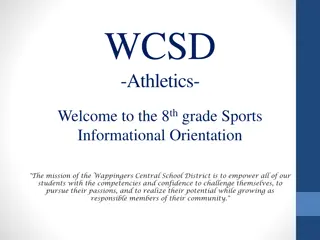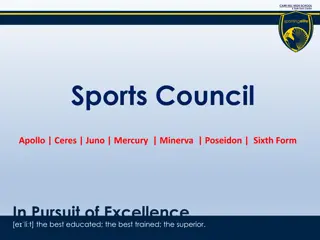Understanding the Importance of Protective Equipment in Sports
Proper selection, fitting, and maintenance of protective equipment are crucial in preventing injuries in sports. Knowledge of safety standards, reconditioning processes, and legal implications is essential for ensuring athletes' safety. Off-the-shelf versus custom protective equipment options also play a significant role in injury prevention and performance enhancement.
Download Presentation

Please find below an Image/Link to download the presentation.
The content on the website is provided AS IS for your information and personal use only. It may not be sold, licensed, or shared on other websites without obtaining consent from the author. Download presentation by click this link. If you encounter any issues during the download, it is possible that the publisher has removed the file from their server.
E N D
Presentation Transcript
Sports Equipment Selection, fitting and maintenance of protective equipment are critical in injury prevention Athletic trainers and coaches must have knowledge of protective equipment available for different sports and proper fitting procedures Protection is critical in contact and collision sports
Safety Standards for Equipment & Facilities Concerns relative to materials, durability, establishment of standards, manufacturing, testing methods, and requirements for its use Must be in place relative to maintenance Concern should be protective ability; not appearance of equipment A number of groups and agencies are involved in standardizing sports equipment and facilities
Equipment Reconditioning & Recertification NOCSAE (National Operating Committee on Standards for Athletic Equipment) Has established test standards in order to reduce head injuries Set minimum safety requirements for helmets and masks for football, baseball/softball and lacrosse Accepted standards for various regulatory bodies in sports Type of helmet, amount of use/intensity will determine condition of help over a period of time
Equipment Reconditioning & Recertification NOCSAE label does not warranty helmets Indicates helmet met requirements when manufactured or reconditioned NOCSAE recommends reconditioning and recertification of equipment Consumer should use discretion based on use
Legal Concerns Increasing amount of litigation regarding equipment Must foresee all uses and misuses and warn user against potential risks inherent in equipment misuse If equipment results in injury due to defect or inadequacy for intended use manufacturer is liable. If equipment is modified modifier becomes liable
Off the Shelf vs. Custom Protective Equipment Off the shelf equipment Pre-made and packaged Can be used immediately Neoprene sleeves, inserts, ankle braces May pose problem relative to sizing
Off the Shelf vs. Custom Protective Equipment Customized equipment Specifically sized and designed for protective & supportive needs
Head Protection Direct Collision sports require head protection due to impacts, forces, velocities and implements Football Helmets NOCSAE developed standards for football helmet certification Must be protective against concussive force While helmets must be certified, they may not always be fail-safe Athletes and parents must be aware of inherent risks
Warning label Warning: Do not strike an opponent with any part of this helmet or face mask. This is a violation of football rules and may cause you to suffer severe brain or neck injury, including paralysis or death. Severe brain or neck injury may also occur accidentally while playing football. NO HELMET CAN PREVENT ALL SUCH INJURIES. USE THIS HELMET AT YOUR OWN RISK.
Revolution Revolution IQ Quick Release Revolution IQ hits
Head Protection Each helmet must have visible exterior warning label. Label indicates that helmet should not be used to strike an opponent due to risk of injury. Also indicates risk of injury accidentally and that athlete plays at own risk while using helmet. Athlete must be aware of risks and what label indicates. Athlete reads and signs statement regarding warning label. There are a number of helmet manufacturers, and even more have closed due to lawsuits and liability cases.
Helmet Fitting When fitting, head/hair should be wet to simulate sweat. Follow manufacturer s directions. Must routinely check fit. Snug fit. With change in altitude, bladder helmets must be rechecked. Chin straps. Jaw pads are essential (prevent lateral rocking). Certification is of no avail if helmet is not fitted and maintained.
Ice Hockey Helmets Must withstand high velocity impacts (stick or puck) and high mass low velocity impacts. Helmet will disperse force over large area and decelerate forces that would act on head (energy absorption liner). Helmets must be approved by Canadian Standards Association (CSA).
Baseball/Softball Batting Helmets Must withstand high velocity impacts. Research has indicated that helmet does little to dissipate energy of ball. Possible solution would be to add additional external padding. Helmet must still carry NOCSAE stamp (similar to football label).
Cycling Helmets Designed to protect the head during one single impact. Many states require use of cycling helmets, especially in adolescents.
Face Protection Face Guard Has reduced the number of facial injuries. Number of concussions has increased because head is most often used in initial contact. There are a variety of protective options depending on sport and position. Proper mounting of the mask must occur with no additional attachments that would invalidate the manufacturer s warranty. All mountings must be flush to the helmet.
Face Protection In high school hockey, face masks are required (with white plastic coating) that meet Hockey Equipment Certifications Council and American Society for Testing Materials. Opening can not allow passage of sticks or pucks. Additional polycarbonate face shields are also available. The use of throat protectors is also mandated at some levels.
Throat Protection Laryngotracheal injuries, while uncommon can be fatal. Baseball catchers, lacrosse goalies and ice hockey goalies are most at risk. Should be mandatory in these sports
Mouth guards Most dental injuries can be prevented with appropriate customized intraoral mouth guards. Protect teeth, minimize lip lacerations, absorb shock of chin blows, and prevent concussions. Should fit comfortably, not impede speech or breathing. Should extend back as far as last molar. Do not cut down mouth guard as it voids warranty for dental protection and could become dislodged and disrupt breathing.
Mouth guards Three types Stock Commercial (formed following submersion in water) Custom (fabricated from dental mold) Mandated use in high school and collegiate levels.
Ear Guards Ear Guards Most sports do not use. Wrestling, water polo and boxing utilize to prevent ear irritation and ultimate deformity of ears.
Eye Protection Devices Highest percentage of eye injuries are sports related. Generally blunt trauma. Glasses May slip on sweat, become bent, fog, detract from peripheral vision or be difficult to wear with headgear. Properly fitting glasses can provide adequate protection. May have polarizing/tinting ability.
Eye Protection Devices Contact Lenses Become part of the eye and move with it. Peripheral vision, astigmatisms and corneal waviness is limited. Will not fog and can be tinted. Disadvantages include cost, corneal irritation, possibility of coming dislodged.
Eye Protection Devices Eye and Glasses Guards Necessary in sports with fast moving projectiles. Athletes not wearing glasses should wear closed eye guards to protect orbital cavity. While eye guards afford great protection, they can limit vision.
Neck Protection Neck Protection Serve primarily as a reminder to athlete to be cautious rather than providing definitive restrictions.
Trunk and Thorax Protection Essential in many sports. Must protect regions that are exposed to the impact of forces. External genitalia, bony protuberances, shoulders, ribs, and spine
Trunk and Thorax Protection Football Shoulder Pads Rules of fitting Width of shoulders must be measured. Inside of pad should cover tip of shoulder in line with lateral aspect of shoulder. Epaulets and cups must cover deltoid and allow motion. Neck opening must allow athlete to raise arms over head w/out pads sliding forward and back. With split clavicle pads, channel for top of shoulder must be in proper position. Straps underneath arms should hold pads firmly in-place, w/out soft tissue restriction.
Trunk and Thorax Protection Sports Bras Most designed to minimize excessive vertical and horizontal movements that occur with running and jumping. To be effective, should hold breasts to chest, preventing stretching of Cooper s ligament. Rib Protection Thorax protectors and rib belts. Protect against external forces.
Protective Equipment Hips and Buttocks Required in collision and high-velocity sports. Boxing, snow skiers, equestrians, jockeys and water skiers. Girdle and belt types. Groin and Genitalia Sports involving high velocity projectiles. Require cup protection for male participants
Lower Extremity Protective Equipment Socks Poorly fit socks can cause abnormal stress on the foot. Should be clean, dry and w/out holes. Shoe selection Number of options for multiple activities.
Shoe Selection Guidelines for selection Toe Box: space for toes ( to inch of space from toes to front of shoe) Sole: provide shock absorption and durable Spongy layer to absorb force. Midsole that cushions midfoot and toes. Hard rubber which contacts the ground.
Shoe Fitting Last: form on which shoe is built Straight = flat arch or run on inside of foot (pronator) Semi-curved = foot to fit normal arch Curved = more forefoot stability, high arch (supinator) Heel Counter: prevents medial and lateral roll of foot. Shoe Uppers: top of shoe made with combination of materials, designed for appropriate ventilation, drying and support. Arch Support: durable but soft and supportive to foot. Price: due to impact on performance and injury prevention, may be worth the extra investment.
Shoe Fitting Shoe fitting Measure both feet, as there will be slight differences. Fit at the end of day due to gradual increase in volume due to weight bearing. Should be snug but allow ample movement of foot and toes. Should break at widest part, coinciding with ball of foot. Must also consider width of shank, non-yielding nature of sole and function of arch support. Cleated and specialty shoes may present problems with fitting. Playing surfaces and activities must be considered.
Lower Extremity Protective Equipment Heel Cups Used for a variety of conditions including plantar fasciitis, heel spurs, Achilles tendonitis & heel bursitis. Used to help compress fat pad, providing more cushion during weight bearing. Foot Orthotics Device for correcting biomechanical problems that exist in foot that can cause injury. Plastic, thermoplastic, rubber, sorbethane, leather support or ready-made products. Can also be customized by physician, podiatrist, athletic trainer or physical therapist.
Lower Extremity Protective Equipment Ankle Supports Can be used alone or with tape. Compared to tape, the device will not loosen significantly with use. Shin and Lower Leg Commercially marketed, hard molded shin guards are used in field hockey and soccer.
Lower Extremity Protective Equipment Thigh and Upper Leg Necessary in collision sports. Pads slip into ready made uniform pockets. Customized pads may need to be held in place with tape and/or wraps. Neoprene sleeves can also be used for support of injuries. Knee Braces Used prophylactically to prevent injuries to MCL. AOSSM has expressed concern about their efficacy in reducing injuries.
Lower Extremity Protective Equipment Types of Braces Rehabilitative Widely used following surgery. Allows controlled progressive immobilization. Adjustable. Functional Used during & following rehab to provide functional support. Ready-made and customized.
Lower Extremity Protective Equipment Neoprene (w/ medial and lateral support) Used by those that have sustained collateral ligament injuries. Some are also used to provide support in those that have patellofemoral conditions.
Elbow, Wrist and Hand Protection While the elbow is less commonly injured, it is susceptible to instability, contusions, and muscle strain. A variety of products are available to protect the elbow. Wrist, hand and finger injuries are often trivialized but can be functionally disabling. Susceptible to fracture, dislocation, ligament sprains & muscle strains. Gloves and splints are available for protection and immobilization.
